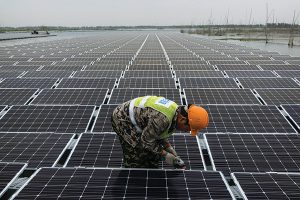Bloomberg
Solar equipment makers are in a fierce competition to cut wafer prices, providing some relief for China’s efforts to install a massive amount of renewable power and reach ambitious climate targets.
Falling solar material prices have driven down costs along the supply chain in recent weeks, with silicon wafers seeing the largest discount. Top player Longi Green Energy Technology Co. lowered its wafer prices by as much as 27% last week, while peer TCL Zhonghuan Renewable Energy Technology Co. cut its quote by as much as 25%.
The “circuit breaker-style†price plunge is fundamentally due to the falling cost of key material polysilicon, according to a statement by China Silicon Industry Association. Solar wafer manufacturers have lowered operating rates because of weaker prices and excessive supply, with some at 60% to 70% of full capacity, it said.
The wafer price war is likely squeezing all manufacturers’ profits, according to a research note by Daiwa Capital Markets. A decision by Longi to make its wafers slightly thinner was likely taken to minimise production costs, the note said.
The trend should give a boost to China’s aggressive push for renewable energy. Polysilicion costs rose to the highest level in a decade earlier this year amid soaring demand and production problems. That drove up panel prices, threatening to delay renewable projects and attracting government scrutiny.
The dramatic fall in costs across the supply chain should make 2023 a big year for solar market demand, according to a video by TCL Zhonghuan.
Even with higher costs and supply chain disruptions, China saw a stellar year of solar installations in 2022. A record 65.7 gigawatts of capacity were added in the first 11 months, and the industry is on its way to install 85 to 100 gigawatts for the full year, according to an industry forecast.
China Starts Work on
Desert Renewables Project
China broke ground on an 80 billion yuan ($11 billion) renewables project in Inner Mongolia, part of a massive clean-power rollout to achieve the nation’s ambitious climate targets.
The project, located in the Kubuqi Desert, will have 16 gigawatts of power capacity when completed, according to a statement by China Three Gorges Group, one of the two builders. It will be able to transmit 40 billion kilowatt-hours of electricity to Beijing, Tianjin and Hebei province annually, with more than half from clean power, according to a report by state media Xinhua News.
The facility is set to become the world’s largest renewable project in a desert region, the company said. It ultimately will include 8 gigawatts of solar and 4 gigawatts of wind energy, plus 4 gigawatts of upgraded
coal power to adjust for peak demand, according to Xinhua.
The clean energy base is part of China’s plan to build 450 gigawatts of renewable power, mainly in spacious hinterlands, and the country last month announced it had started building 95 gigawatts in the first phase. China aims to have 1,200 gigawatts of wind and solar power by 2030, the year the country aims to peak carbon emissions.
China Three Gorges didn’t give a time frame for the Inner Mongolia project’s completion, but said the current construction phase includes 1 gigawatt of solar capacity equipped with energy storage.
The energy base is one of 22 renewable power projects that Three Gorges launched, with a combined planned capacity of 19.6 gigawatts and total investment of 101 billion yuan, according to a statement by the State-Owned Assets Supervision and Administration Commission.
 The Gulf Time Newspaper One of the finest business newspapers in the UAE brought to you by our professional writers and editors.
The Gulf Time Newspaper One of the finest business newspapers in the UAE brought to you by our professional writers and editors.
